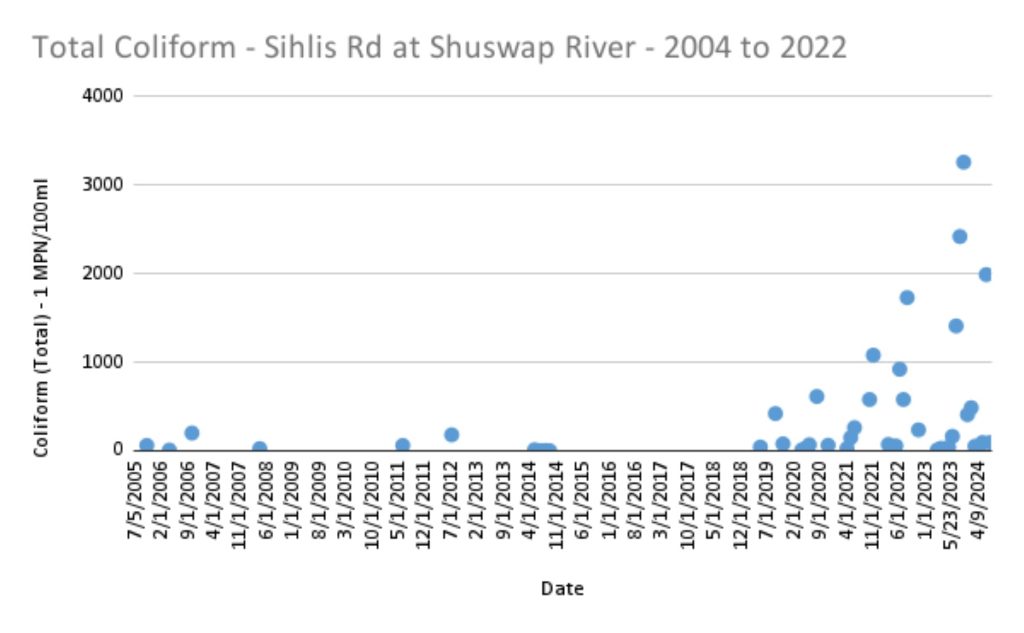
Cherryville and rural Lumby residents are outraged about the polluted water in the middle Shuswap River that is likely due to the runoff from an intensive cattle operation that is essentially a small feedlot located on a plateau above the river between Cherry Creek and Ferry Creek. Concerns about water quality began when a resort was being expanded on Sugar Lake. A citizens group was formed, the Cherryville Water Stewards, to advocate for protection and with funding from the regional district it has been testing the water in the river four times a year since 2008.
In part due to their efforts, the resort was mandated to install a proper septic system and to test it regularly to ensure it continues to work properly. Thus, the river has been relatively clean until a few years ago. Tim Staker lives along the river and has been doing the water testing. Four years ago, he began noticing increased E-coli and colloform numbers in the river downstream from the village, far above the safe level of zero for drinking water and 200 for swimming.

Three years ago, during the spring run-off, residents noticed a 20-foot-wide waterfall of brown water pouring off the hillside below the feedlot, where it eventually made its way into the river. After complaints were directed to the Ministry of Health and the Ministry of Environment, a pipe was installed that basically only served to hide the polluted water. This spring, when Tim tested the water flowing through a culvert into the river, the results showed a count of 2,420 of E-coli and 2,450 coliform, which is the highest possible number and thus it could have been even higher. Fortunately, he had his rubber gloves on!

The cattle operation that feeds upwards of 600 cows is one of many owned by a local multi-millionaire who has recently purchased five more ranches in the valley. Government inspectors have visited the 160-acre feedlot multiple times over the last five years, but due to the right-to-farm legislation, nothing much can be done to reduce the numbers of cattle or prevent the problems from continuing. The owner had also set up a large capacity irrigation system without a water licence or riparian permit, but it has not been used due to the concerns of the staff.
On May 23rd, a local environmental group, BeeSAFE, sponsored a public meeting at the Cherryville Hall that was attended by over 150 residents. SAFE stands for “safe agriculture and food economy.” At the event, BeeSAFE founders Huguette Allen and Carla Vierke gave a presentation that included the results of the water testing that shows how the levels of pollutants have been increasing since the feedlot was established. Years ago, residents of often drank the water in the river and now they are now concerned about even swimming in the river, and some are worried about the water in their wells.
A petition calling for government agencies to “immediately protect water at source in the Middle Shuswap River by removing all intensive livestock operations where manure in produced in excess of the natural absorption of the land” was signed by most in attendance and is also available online.
Currently, the community is waiting for the latest Ministry of Environment report about the issue that is expected to be released soon as a result of a recent investigation. Hopefully, the government will take action and force the rancher to remove the feedlot, as this would be the only acceptable solution. However, it is rare for the government to use its limited powers to stop pollution at its source, especially when the problem is caused by agricultural practices. Throughout the world, there are rivers, lakes and even parts of oceans that are so polluted from industrial agriculture that the water is unsafe for both humans and wildlife. We must not let that happen here in the Shuswap.
POSTSCRIPT
Longtime Cherryville resident, Claude Labine has also been testing the water in the river and has data since 2004. He prepared this graph that shows how there have been high concentrations of coliform in the river in the past four years, since the cattle operation began.

After the residents submitted their complaint and the government began an investigation, the rancher removed the cattle and began cleaning up the piles of manure. In response to my inquiry, the Ministry of Environment sent me this email:
“Environmental Protection Officers were recently in the area conducting inspections and ensuring agricultural activities adhere to the Code of Practice for Agricultural Environmental Management under the Environmental Management Act.
These regulations apply to all agricultural operations in BC, from hobby farms to large commercial operations. Cattle ranchers are required to ensure that contaminated runoff, solids, and air contaminants do not enter a watercourse, cross a property boundary, or go below the water table. More information on the regulatory requirements can be found here: https://www2.gov.bc.ca/gov/content/environment/waste-management/industrial-waste/agriculture
Staff are reviewing the findings and will publish an inspection report in the coming weeks on the Natural Resources Compliance and Enforcement Databasehttps://www2.gov.bc.ca/gov/content/environment/research-monitoring-reporting/reporting/environmental-enforcement-reporting“
Cherryville and rural Lumby residents are still waiting for this report. Learn more and sign the petition here.

Most recently, Bee S.A.F.E. is working with West Coast Environmental Law to provide “personhood” for the Shuswap River, which would provide it with greater protection from pollution.
If the rancher had been following the government’s code of practice for agricultural environmental management, then the river would have remained pristine and free from pollution. Here is where to find this code of practice – CODE
Here is where to find the test results taken by the Cherryville Water Stewards: TEST RESULTS and below is a map showing where testing has occurred.







